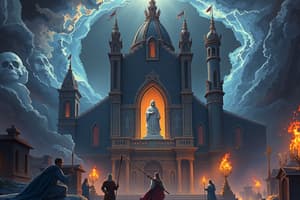Podcast
Questions and Answers
What was the Counter-Reformation?
What was the Counter-Reformation?
A religious and political movement that involved the creation of new practices and policies in the Catholic Church.
When did the Thirty Years' War in Central Europe begin?
When did the Thirty Years' War in Central Europe begin?
When Lutheran princes challenged the Holy Roman Emperor, who was Catholic.
What is another name for the Counter-Reformation of the 1500s?
What is another name for the Counter-Reformation of the 1500s?
The Catholic Reformation.
What did the Roman Inquisition create during the 1500s?
What did the Roman Inquisition create during the 1500s?
What agreement was reached by the Council of Trent?
What agreement was reached by the Council of Trent?
What event broke the Peace of Augsburg?
What event broke the Peace of Augsburg?
What reform was initiated by the Council of Trent?
What reform was initiated by the Council of Trent?
Who did the Peace of Augsburg end the conflict between?
Who did the Peace of Augsburg end the conflict between?
What describes the Roman Inquisition?
What describes the Roman Inquisition?
What is the correct order of events from the English Reformation?
What is the correct order of events from the English Reformation?
To which religion did Mary I belong when she became the Queen of England?
To which religion did Mary I belong when she became the Queen of England?
What led to the creation of the Church of England?
What led to the creation of the Church of England?
Why did Mary I earn the nickname 'Bloody Mary'?
Why did Mary I earn the nickname 'Bloody Mary'?
What did Mary I do when she became the Queen of England?
What did Mary I do when she became the Queen of England?
Which leader restored the Church of England?
Which leader restored the Church of England?
What occurred in Germany by 1560 in relation to the spread of religions?
What occurred in Germany by 1560 in relation to the spread of religions?
What was an effect of the Great Peasants' Revolt?
What was an effect of the Great Peasants' Revolt?
Flashcards are hidden until you start studying
Study Notes
Counter-Reformation Overview
- The Counter-Reformation was a movement aimed at reforming the Catholic Church's practices and policies.
- Known also as the Catholic Reformation, it emerged in response to Protestant Reformation challenges.
Thirty Years' War
- Began due to Lutheran princes' rebellion against the Catholic Holy Roman Emperor.
- Significant conflict in Central Europe, impacting religious and political dynamics.
Roman Inquisition
- Established to maintain church authority by prosecuting heresy.
- Produced a list of prohibited books for churchgoers, aiming to curb dissent.
Council of Trent
- Convened to address corruption and reaffirm church doctrines.
- Instituted the creation of seminaries for priest training and established an administrative system to prevent corruption.
Peace of Augsburg
- Agreement that sought to resolve conflicts between German princes and the Holy Roman Emperor.
- Failed to maintain peace and was ultimately disrupted by the Thirty Years' War.
English Reformation Key Figures and Events
- Henry VIII's break with the Catholic Church led to the formation of the Church of England.
- Mary I, a Catholic, attempted to restore Catholic ties and persecuted Protestants, earning the nickname "Bloody Mary."
- Elizabeth I later re-established the Church of England, reinforcing Protestantism.
Religious Distribution in Europe
- By 1560, Germany largely adopted Lutheranism, showcasing Protestant influence in the region.
Great Peasants' Revolt
- Resulted in significant violence, with approximately 100,000 peasants losing their lives.
Studying That Suits You
Use AI to generate personalized quizzes and flashcards to suit your learning preferences.




